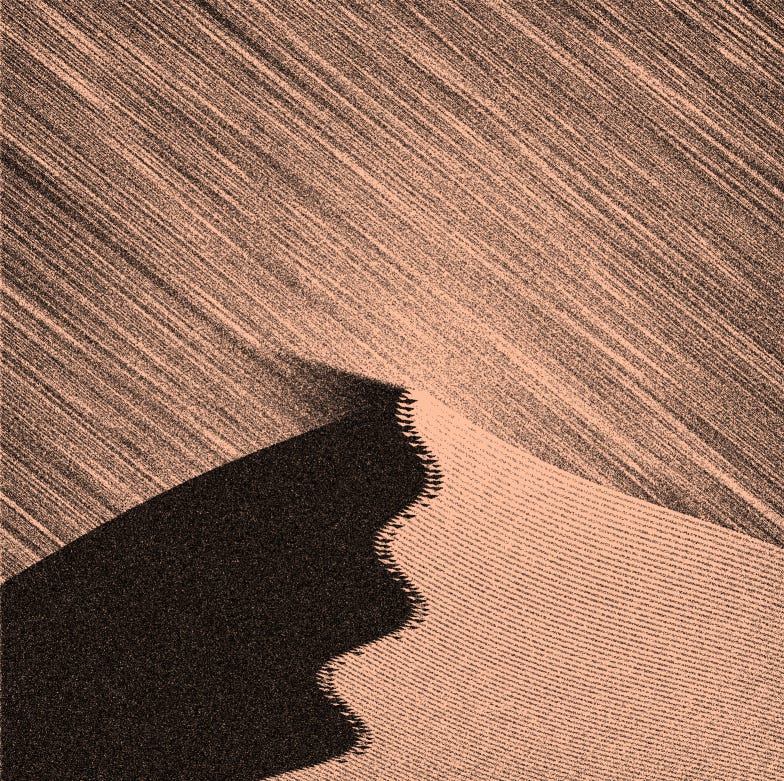🏜 Lunarean's Sandy Algorithm Produced Golden Dunes...
Find out more about Lunarean's creative process and what inspired Solace...
What a month! We have learned many things from twenty-one NFT artists so far, and today we have a new one (and a special one). In case you didn’t know, I’ve been writing one article per day for the #30NFTartists30days series. Don’t forget to subscribe to don’t miss the final eight stories…
Today’s generative NFT artists created one of the top collections on the FxHash platform. Lunarean is a software developer who only needed two collections to break out as an exciting innovator in the on-chain art movement. He made his masterpiece (Solace) using as inspiration the word “sand.” In the beginning, he just made a sketch but noticed how the procedures could be generalized to produce not only one sand dune but many more. The rest is history.
“Solace is an algorithm that generates artworks of sand dunes. It draws hundreds of thousands of tiny points according to a probability distribution calculated from the positions of the dunes.
The logic to divide the dunes into light and dark sides is simple but produces some interesting chaotic behavior. These are details that weren't hard-coded but emerge organically, such as the patterns on the spines of the dunes or the stripes around their bases.”
How long have you been coding? How long have you been making generative art?
I’ve been coding for a while since I was a kid, and my main work is actually as a developer. I discovered generative art a couple of years ago through the works of Jared Tarbell. I was fascinated by systems like chaotic attractors and fractals where simple rules could produce beautiful complex results, so I started playing around with those systems myself.
Let’s dive into the economics behind Solace. It minted out for 12 Tezos (+/- $40) and quickly started to move on the secondary market. It broke the 100 Tezos floor barrier relatively fast and kept raising slowly. Once it passed the 300 Tezos floor mark, it skyrocketed and broke the 1k Tezos floor in a few weeks. Currently, the cheapest Solace in the market costs 1.5k Tezos (+/- $6k). The total volume has been over 55k Tezos (+/- $200k), putting Solace among the hottest collections on the whole Tezos blockchain.

What inspired you to create Solace? Did you expect this huge success?
During January, I took part in Genuary, an event where you’re given a prompt each day as an inspiration for a generative artwork. One of the prompts was “sand,” and my idea was pretty simple - a sand dune drawn with lots of tiny points, like sand grains. I really liked the resulting sketch, so I explored the concept further. When I realized that the underlying algorithm was pretty generalizable and could produce a wide variety of outputs, I decided to expand it into a long-form series.
While working on Solace, I felt the produced outputs were pretty strong (though I wasn’t sure if it was just personal bias), and the WIPs I posted on Twitter were also getting great feedback, so I was feeling optimistic. But even then, I definitely did not expect the amazing response to Solace - it really felt overwhelming and surreal at times.
How long did it take to code the whole collection?
The initial version took only a few days, but tweaking and refining it took around a month.
My process was to generate a batch of 100 outputs, then look at them one by one, taking notes on things that could be improved. I’d also assess the whole collection of thumbnails to see how it looked as a whole. Then I just repeated this again and again, aiming to improve the algorithm gradually each day.
Later in the process, some features were added, such as the different render types or rare variations like Dancers and Sandstorm.

Besides Solace, lunarean coded a smaller collection called City in the Wind. It is much smaller (only 32 pieces), and the floor (the cheapest available in the market) is 999 Tezos (+/- $4k). Imaging minting one of these for just 1 XTZ (less than $5) a few months ago…
What are your future plans NFT and art-related?
I definitely plan to release more work on fxhash, though I’m not sure when that might be. For the moment, I’m just exploring ideas and creating sketches casually. I’m finding it pretty fun, and it’s also an excellent way for me to learn new techniques. If I like a sketch and the underlying algorithm seems generalizable, it could become the basis for a long-form series.
At some point in the future, I’m also interested in creating a generative series where the execution is fully done on-chain and creating artwork with more interactive elements built into the smart contract.

Who are your favorite NFT artists?
I love the work of generative artists like Jared Tarbell, Anders Hoff, Tyler Hobbs, and William Mapan, among many others. I’ve also enjoyed collecting work on fxhash - there are far too many outstanding collections to name, but my favorites include “Art For Walls In Public Spaces” by Anna Lucia and “ukiyo-e seascape” by ykxotkx.
If you don’t want to miss lunarean next drops, follow him on his Twitter account.
Until next time,
Kaloh







